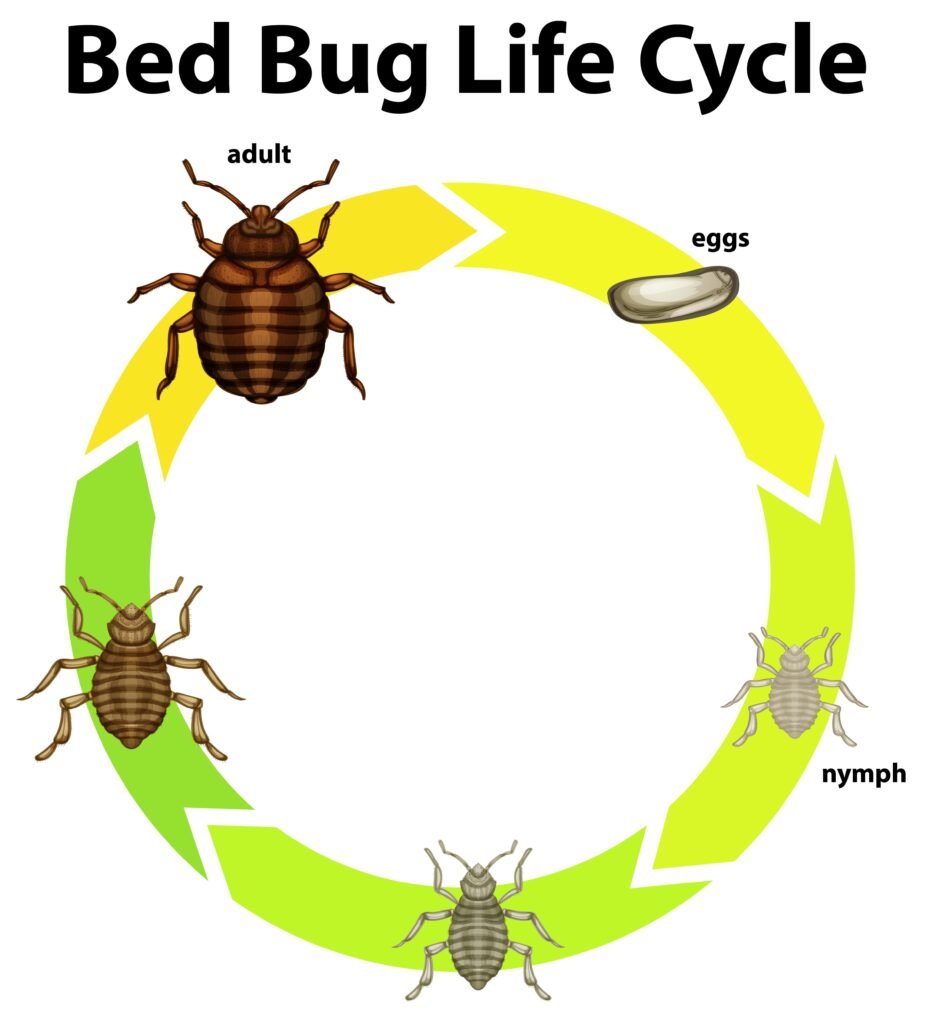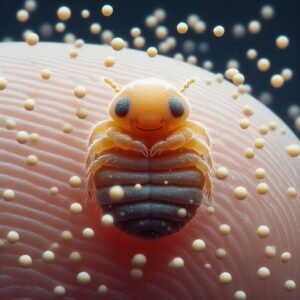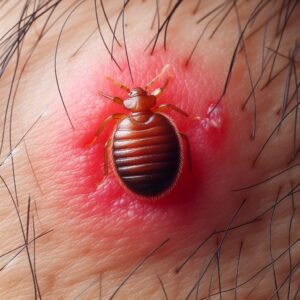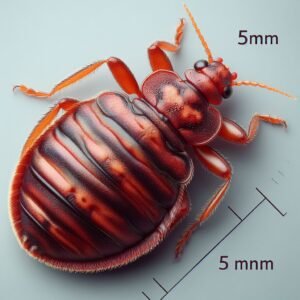what do bed bug eggs look like? Bed bugs are a nuisance that can infest homes and multiply quickly if left untreated.
The female bed bugs lay tiny eggs that are sometimes difficult to see on your own. Learning what bed bug eggs look like and where they hide is key for controlling these pests. This article will cover everything you need to identify bed bug eggs and clean them properly.
Definition of Bed Bugs & Why They Are Problematic
Bed bugs are small, flat, oval-shaped insects that feed exclusively on blood. They hide in dark crevices and come out at night to bite exposed skin, leaving itchy welts. Bed bugs can rapidly spread from room to room and are difficult to control without professional treatment.
A bed bug infestation starts when a pregnant female bites a human host to obtain a blood meal. She then lays eggs in hidden spots near sleeping areas. The eggs hatch within 6-10 days into nymphs which must also feed on blood. From egg to adult, the bed bug life cycle ranges from 4 weeks up to several months.
Females may lay up 200-500 eggs over their adult lifespan of 6-12 months. Such high reproduction rates enable bed bug populations to quickly get out of control. This is why identifying and properly removing bed bug eggs is a crucial part of eliminating an infestation.
What do Bed Bug Eggs Look Like?

Size & Shape
Bed bug eggs measure roughly 1 millimeter long, about the size of a dust spec. They have an oval shape and look something like a grain of rice. The eggs have a slightly curved appearance from their glued underside which attaches them to surfaces.
Newly laid bed bug eggs will appear more round and plump. Over time as the eggs mature, they flatten out and elongate in preparation to hatch. Their small size makes them easy to overlook during early stage infestations.
Color
When first laid, bed bug eggs look pearly white or clear in color. This enables them to easily blend in with their surroundings. Over the 6-10 days of development, the eggs turn tan, golden, or brown colored. Once the darker nymphs are visible through the shell, it has nearly finished incubating.
The color change acts as your visual cue to identify viable eggs versus hatched or infertile ones. Empty egg shells will maintain their tan, desiccated appearance. Live eggs still incubating will look more vibrant and lush.
Common Hiding Places of bed bugs
Female bed bugs prefer to deposit eggs in cracks, crevices, and secluded corners that offer protection. Mattress seams, box spring encasings, bed frames, and headboards provide ideal harborage. But eggs may also hide behind baseboards, pictures frames, electrical switch plates, and furniture joints.
Recommended post: 12 Bed Bug Myths Debunked: Separating Fact from Fiction
Clutter like stacks of clothing, shoes, toys, or linens also supply numerous spots for females to hide their eggs. The difficulty in detecting the small eggs allows infestations to grow over longer periods before definitive signs like fecal spots or bite marks raise red flags.
10 Tips to Effectively Clean Bed Bug Eggs
If you confirm or suspect a bed bug problem, taking immediate steps to clean and kill the eggs is vital for gaining control. Here are 10 tips to effectively remove eggs during treatment.
1. Inspect and Identify Eggs
Carefully examine areas around sleeping spaces to try and identify eggs directly. Their small size can make them easy to miss, so use a flashlight and magnifying glass if needed. Focus on cracks in wooded furniture, corners of mattresses, and hidden spaces where adults may hide or travel. Mark spots where eggs are seen for targeted treatment.
2. Vacuum Visible Eggs
For eggs laid out in the open, use a vacuum with a hose attachment to suck them up. This helps eliminate some eggs from hatching. Just make sure to safely dispose of the vacuum contents in a tightly sealed bag afterwards so nymphs cannot escape back into your home.
3. Wash Infested Fabrics
Bedding, linens, curtains, and clothing used around potentially infested areas should be washed in hot water and dried on the highest allowable heat setting to kill living eggs. After drying, clean items should be placed in sealed plastic bins or bags to prevent re-infestation.
4. Apply Targeted Steam
A handheld steamer is very effective for forcing bed bugs and eggs out of hiding. Apply steam directly into cracks and crevices where eggs may lurk. The heat from the steam will also instantly kill live eggs. Be careful when using steam around electronics and plastics which can melt.
5. Seal Entry Points
Seal up baseboards, electrical outlets, windows, picture frames or any cracks allowing bed bugs access with caulk. This helps make formerly utilized harborage spots unusable. Paint over sealed areas for an extra layer of protection.
6. Use Egg-Killing Products
Apply residual bed bug sprays, powders, or dusts labeled to kill both live bed bugs and eggs. Products containing insect growth regulators prevent nymphs from fully maturing. Apply these chemicals based on label directions into impacted rooms and furniture.
7. Mattress Encasements
Covering mattresses and box springs with bed bug proof encasements traps eggs inside and keeps new ones out. Leave encasements on for at least 18 months because sealed eggs can take that long to die inside. Properly installed encasements also reduce pesticide needs.
8. Remove Clutter
Thoroughly clean then declutter infested rooms to eliminate dark hiding spots attractive to bed bugs. Getting rid of unnecessary items also cuts down on egg laying locations and makes future inspections easier. Store essential items in sealed bins elevated off the floor.
9. Discard Heavily Infested Items
In extreme infestations with eggs saturated deep inside furniture joints or mattresses, the best option is to responsibly discard the irreparably infested items. Cover discarded items in plastic for transport to avoid spreading eggs elsewhere.
10. Post Treatment Monitoring
Even after thorough cleaning efforts, eggs or surviving bed bugs may have been overlooked. Continue inspecting for signs of re-infestation like fecal markings, molted skins or bite marks for at least 2-3 months afterwards. Ongoing monitoring allows for targeted follow up treatment of any lingering pests.
Also Read: Are bed bugs dangerous?
Can you see bedbug eggs?
Yes, bedbug eggs are visible to the naked eye, although they are tiny, about the size of a pinhead and translucent white. They are usually found in clusters, often in crevices and seams of mattresses, furniture, or behind baseboards. Regular inspection and thorough cleaning can help identify and eliminate these pests before they become a bigger problem.
Can bed bug eggs be killed?
Yes, bed bug eggs can be killed. Applying heat treatments, using insecticides specifically designed for bed bugs, or employing steam treatments are effective methods to kill bed bug eggs. It’s important to target both the eggs and the adult bed bugs to fully eradicate an infestation. Regular monitoring and repeated treatments may be necessary to ensure all eggs are destroyed.
What do freshly laid bed bug eggs look like?
Freshly laid bed bug eggs are tiny, typically about the size of a pinhead, and appear translucent white. They have an elongated oval shape and are slightly curved. These eggs are often found in clusters and are sticky when first laid, adhering to surfaces such as fabric or wood. Regular inspection for these characteristic clusters can help detect bed bug infestations early.
How do you identify bug eggs?
Identifying bug eggs typically involves examining their size, shape, color, and location. Bug eggs vary widely in appearance depending on the species. They may be round, oval, or elongated, and range from translucent to opaque, depending on their stage of development. Additionally, they’re often found in clusters, adhering to surfaces near a food source. Consultation with a pest control expert can aid in accurate identification.
Do bed bug eggs stick to mattress?
es, bed bug eggs can stick to mattresses. When first laid, bed bug eggs are often coated with a sticky substance that helps them adhere to surfaces. Mattresses, with their numerous seams and folds, provide ideal hiding spots for bed bugs to lay their eggs. Regular inspection and cleaning of mattresses are essential to detect and remove any eggs or bed bug activity.
what do bed bug eggs feel like
Bed bug eggs typically feel slightly sticky or tacky when first laid. This adhesive quality helps them to adhere to surfaces, such as fabric or wood, where they are deposited by female bed bugs. As they mature, the sticky coating may dry out, but freshly laid eggs may still have a slightly tacky texture.
Conclusion
Identifying and properly removing lingering bed bug eggs is challenging but essential for freeing a home from infestation.
Now that you know what bed bug eggs look like and where to find them, you can better inspect for and destroy them. Pair egg removal efforts with professional chemical treatments and ongoing monitoring to stop bed bugs in their tracks.





